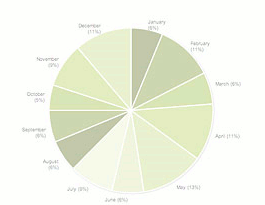


Increase in Women in Academic Medicine
Dear friends of women in science,
The Association of American Medical Colleges released data analysis of professors at medical schools that was highlighted in the NIH report on women in science recently. The report and data are here. The information was collected from the AAMC faculty roster, the only national database of medical school faculty. The report compared the percentage of women in various faculty categories in 1969, 1989, and 2009. It is partly a response to previous analyses that pointed out that students in medical school were more diverse than faculty. They said, "In 2009, for example, 48.8 percent of U.S. medical school graduates were women and 35.7 percent were non-white whereas 34.9 percent of U.S. medical school full time faculty were women and 25.9 percent were non-white." That's a substatial discrepancy between students and faculty, but to be fair, we should look at where the faculty were a short time ago.
From the table they present, the women full professors increased in their three study years from 4.7% to 8.6% and then to 18.7%. Among assistant professors, the percentage was 19.4% in 1969, 28.5% in 1989, and 41.7% in 2009. The only sad part of the statistics is that among instructors/other, women rose from 32.5 to 51.9 percent in the same period, implying more success in the lower status positions.
Do you see this as glass-half-full? Is it something to celebrate?
cheers,
Laura

Many state-supported medical schools still have "hard-money" faculty slots, but it is becoming more and more rare. As for what happens if NIH funding continues its downward spiral, the MDs in clinical departments shift to more clinical activities, but the pressure is really on the PhDs (a high proportion of R01 PIs) who are under the gun. Many science societies and
NIH leaders are pushing for a cap on number of R01s/PI and amount of PI salary that can be paid from a grant - but the AAMC (Association of Medical Colleges) is battling hard against that - and they have a powerful lobby!
Hi Phoebe,
So if Congress downsizes NIH, and each professor gets 2 RO1 grants, their salaries are cut by 1/3 and they leave to go into private practice perhaps? Uh oh. Doesn't sound viable long term.
Years ago when I was at U Colo Med, each preclinical dept had several paid slots and could only add faculty by this kind of deal. I guess it's gone 'viral" as a strategy now.
cheers,
Laura
In answer to Laura's question -
Undoubtedly the biggest driver towards entrepreneurship in med schools is the requirement for paying almost all of your faculty salary from soft money - since you will be doing very little teaching. Latest calculations are that a tenured med school faculty running a research lab of "appropriate" size and supporting several grad students (with no TAs) and post docs will need 3 simultaneous R01s.
Hi Phoebe,
How very interesting, but depressing. It's a little bit surprising to me that the med school faculty emphasize entrepreneurship so much more than the top ranked non-med school faculty. Is there another criterion that seems to take up the slack in the non-med school departments? Publication over grants/industry leverage perhaps?
cheers,
Laura
I recently completed an informal census of female basic science faculty in 17 highly ranked med schools, comparing the numbers of full-time tenured and tenure-track with similarly highly ranked non-med school departments of biology and chemistry. The answer: the med school school departments average 5% fewer female faculty than the non-med departments. My hypothesis is that this related to the med school emphasis on self promotion, entrepreneuralism and requirements to land more grant funding - particularly the research-intensive med schools. And- I see the same pattern with African-Americans, although the numbers of African-American basic science faculty are tiny.
Comments?
OK, I guess it's definitely BETTER. But not yet GOOD in my book, so half-full is about right! I think they should find a lot more full profs. I'll bet there is plenty of attrition among the ranks of those junior professors surrounded with you-know-what kind of remarks, etc.
I don't know, Laura, 18 percent is not worth much champagne in my book. But it may be faster than Harvard. The trend is good, I'll give you that much.

















